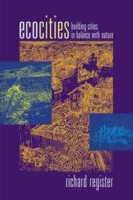This book is every bit as rich, dense, and lush as the proposed development that bears its name.
By Ryan McGreal
Published December 14, 2005

Ecocities: Building Cities in Balance with Nature
Cities must learn to sustain themselves without stripping their own capital or that of their surroundings.
That's the thesis of Richard Register's book Ecocities: Building Cities in Balance with Nature. It's a passionate defence of an imagined city that exists today only piecemeal in scattered fragments throughout the world and through history.
This book is every bit as rich, dense, and lush as the proposed development that bears its name. I've read and re-read it in the past three months, but every time I try to write a review, its essence slips through my fingers like so many beautiful moments in time.
One of Register's central arguments is that people have been trying to build cities in balance with nature all along but have continually been led astray. In particular, sprawl emerged from the legitimate desire of urban residents in dirty industrial cities to escape the filth and crowding and live close to nature. He calls this the "ecocity impulse,"
the desire to enjoy city and country life simultaneously. Suburbia is one response to the impulse, but it fails because it doesn't really provide either city or country life. Its gross deficiencies are ameliorated by heavy use of automobiles to emulate the proximity implied by city life, plus regular vacations to cottages and resorts to emulate the tranquility of country life."
Register scavenges history for examples of sustainable cities. His search takes him from Minoan Crete in ancient Greece to a lost city nestled in the foothills of the Sierra Nevada de Santa Marta in Colombia - and several points between.
To understand how North American cities might escape their overwhelming petroleum dependence, Register considers the city through a number of dimensions: evolution, nature, and history.
First, he argues, like Paolo Soleri, that cities draw numerous small elements together, which combine and recombine into complex relationships that generate novel elements. He draws the analogy between city development and biological evolution, treating cities as large, complex organisms.
Even our current, environmentally destructive cities support managed biodiversity through trees, gardens, wildlife, and pets. City people enjoy when nature intrudes on modern life, as it does during major storms. As Register notes, birth rates go up nine months after blackouts.
For cities to function efficiently, distance is critical. As the distance between destinations - between people who interact and processes that consume inputs and generate outputs - goes up, so does energy use, waste, and land use, or "footprint".
"Access by proximity" is a common refrain. Sustainable cities must be dense, diverse, and complex. In Register's words, "The shortest distance between two points is moving them together; every trip from then on is shorter. That's an efficiency multiplied thousands of times."
He also contrasts the philosophies of cities and villages, arguing that the former are engines of innovation whereas the latter are bastions of preservation. Time in the village is circular, but time in the city is linear and progressive.
In the village the idea of cutting down a tree might have caused the elders to point out the value of the tree to useful and beautiful birds, to children who likes to climb in its branches, to villagers who benefited from its shade in the summer. But the city's style of creativity would have seen the potential for wood to produce more housing, tools and furniture, and as a fuel for firing pottery and melting gold and bronze.
Cities generated wealth beyond subsistence. This produced the sheer sensual richness that attracts people to cities today: "magnificent architecture and sculpture, writing, math and astronomy, dangerous concentrations of power, the sweet smells and moist airs of gardens, shady luxury with occasional fine things to eat and drink, pungent marketplaces, and hot dusty streets filled with strangers and acquaintances in a pact to accept one another."
The city in history was a shelter from the dangers of the wild world outside, exemplified by Europe's forests: "monsters, criminals, and diabolic forces." Ironically, our contemporary attitude toward downtown city centres is remarkably similar to medieval Europeans' attitudes toward their forests.
The very complexity and diversity that characterizes urban, as opposed to suburban, life produces novelty and unpredictability, not all of it beneficial. By contrast, suburban life is much more heavily managed, and there is little opportunity for the kinds of interactions among living things that cumulatively produce biodiversity.
Instead of the self-regulation of an emergent system, suburban life is founded on regulations, governing construction, and placement and use of all buildings, leaving little opportunity for the evolutionary process of complexification, miniaturization, and reproduction.
Instead, the forces of development are moved into the abstract world of globalized commerce, managed by large corporations and taking place in a notional "market" of investment flows and macroeconomic factors, all powered by massive infusions of fossil fuel energy.
Such is the derangement of suburbia as a failed attempt to integrate village and city.
Register responds with his three major prescriptions: "conserve, recycle, and preserve biodiversity." He then goes on to describe the ecocity in great detail, explaining its layout, structure, transportation systems, energy use, water management, food production, manufacturing, and economy.
His detailed descriptions of what ecocities might look like, which occupies the second half of the book, are far too robust to summarize in a few paragraphs. His frequent illustrations help the reader to visualize his imaginings, but his descriptions are at least as rich and artistic as the renderings.
I urge anyone who takes sustainable urban development seriously to read this book.
You must be logged in to comment.
There are no upcoming events right now.
Why not post one?